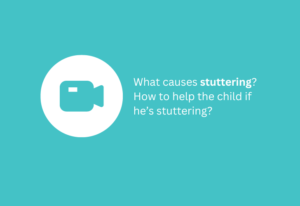Stuttering in Children (التأتأة عند الأطفال) is a type of fluency disorder (اضطراب الطلاقة) marked by interruptions in the natural flow of speech. These may include repeated sounds, syllables, or words, prolonged sounds , or involuntary pauses. While stuttering (التلعثم) can affect people of all ages, it often begins in early childhood.
Consult Talking Brains Center (TBC) in Dubai for specialized speech and language therapy (علاج النطق واللغة) if you notice any of the following:
The stuttering (التأتأة) continues for 6 to 12 months or more.
It starts after the age of 3½ years.
It happens frequently.
Your child shows visible signs of struggle while speaking.
Stuttering or fluency disorder is a communication disorder that occurs during the speaking process. A child does not stutter if he is talking to himself, an animal or a baby. Likewise, he does not stutter while singing or playing a comedy.
The normal speech is not always fluent; thus, it is normal to hesitate, pause and search sometimes for words. The normal speech is a living speech: it follows the rhythm of the speaker’s thoughts and feelings.
It could also carry some disruptions that can be manifested in repeating syllables and elongating “euh”. The speaker having these disruptions or “stammers” should relax and proceed calmly with his or her words.
However, the child who stutters is fighting against syllables and words. He/she makes some efforts to hide his or her stammers in front of his correspondent, who is considered as a judge.
According to the phonetician Francois Le Huche, stuttering involves some efforts to be done or already done so as to speak better despite the stutter (which exists in our normal speech).
The extreme desire to control our language and to overthink how we could express ourselves leads to stuttering.
85% of children around 3 years old suffer from physiologic stuttering marked by the repetition of the first syllable or first word of a sentence. The beginning could be progressive or brutal and may persist for around one week minimum for children who don’t suffer from speaking problems. According to statistics, this stuttering disappears spontaneously for 3 out of 4 children, while the 4th child will remain stuttering. That is why it’s advised to visit a speech therapist who can give some parental guidance or advice about dealing with their child at an early age.
Disruptions, hesitations and repetitions of syllables do exist in our normal speech; thus, they are not a proof of stuttering.
The accurate sign of stuttering is the child’s muscle tension while or before speaking. This tension might be general (among all his body) or precise (among his jaw, lips, neck….). The child will get angry, stiffen, avoid eye contact, and speak slowly to hide his stutter…
Stuttering is the result of multiple factors:
- Predisposing factors which prepare the field:
Concerning the child, we mention his will to get rid of his disorder, some psychometric difficulties, a perfectionist character and some psychological difficulties. While concerning the environment, we note the excessive requirements from some parents who refuse that their child stutters fearing of getting used to this habit. Other parents who are always fully charged raise their child under a punctual pressure (speak rapidly; I don’t have much time…).
- Triggering factors which are some shocking events for the child, such as mourning, fire, location changes, birth of a sister or brother, distance…
These factors require a detailed evaluation.
In order to distract the child from the required efforts to convey his or her message in a good manner, it is important to be an active correspondent who first of all shows interest in the content of the message, as the child will feel it not just by our spoken words but by our reactions, looks as well in our body language.
Thus, we should not give good advice shedding the light on the importance of conveying the message, for instance: breathe, think before speaking, relax, stay cool, take your time, and speak slowly…
In addition, mockeries and imitations of the stuttering child hurt; therefore, it is preferred to avoid them.
Some parents are disinterested in this difficulty even though their child suffers while speaking. This attitude is to be avoided as well, since it will lead to non-speaking state, while the best attitude is to give the child his time to speak; and if he/she blocks, we can suggest the word he/she wanted to say, if it wasn’t the right one, we can give him other words to know if we got his point… we usually adopt this attitude with everyone who doesn’t stutter.
Thus, we should not make a mystery out of stuttering.
Stuttering is diagnosed by a speech pathologist in order to differentiate between the psychologic and authentic stuttering, thus the importance of his early interference to avoid stuttering.
The speech therapy rehabilitation consists of making the speech and communication mechanism clearer to the stuttering person by teaching him how to relax, breathe…
This rehabilitation process is accompanied by a parental guidance which consists of giving advices to the parents with the purpose of reacting in a better way with their child. Usually, an additional psychological follow-up is necessary, and in some cases, if the child is unable to relax, he or she is advised to undergo some psychomotor therapy sessions.
The Lidcombe Program targets behavioral treatments for children, under the age of 6, suffering from stuttering and fluency disorders. The program is administered by a parent in the child’s everyday environment, with the supervision of the speech and language therapist. Parent training is an essential part of the program to help understand how it works. The treatment is direct and involves the parent commenting on the child’s speech.
Therapy after the age of 6
At TBC, our speech and language therapists in Dubai provide individualized therapy sessions in Arabic, French, and English to help clients overcome stuttering. Therapy focuses on enhancing communication skills, building confidence, and reducing the impact of stuttering on daily life.



